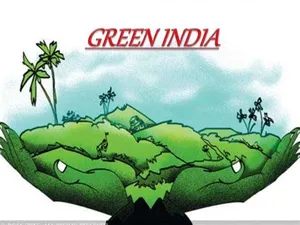


In the post-budget webinar on green growth, Prime Minister Narendra Modi observed that “India has been the fastest in renewable energy capacity addition among major economies since 2014. The potential of solar, wind and biogas in India is no less than any gold mine or oil field for our private sector. India has huge potential to lead the world in Green Energy. It will forward the cause of global good apart from generating Green Jobs”.
The Prime Minister outlined three pillars for green growth and energy transition – increasing the generation of renewable energy, reducing use of fossil fuel in the economy and moving rapidly towards a non-fossil fuel gas-based economy in the country. This strategy has underlined the announcements of measures like ethanol blending, PM KUSUM Yojana, incentives for solar manufacturing, rooftop solar scheme, coal gasification, green hydrogen and battery storage, in the budgets of the past few years.
The Prime Minister highlighted schemes such as green credit for industries, PM Pranam Yojna for farmers, Gobardhan Yojna for villages, vehicle scrapping policy for cities, Green Hydrogen and wetland conservation. India has achieved the target of 40% contributions from non-fossil fuels in the installed electricity capacity 9 years before the target date and has also achieved the target of 10% ethanol blending in motor spirit 5 months before time.
Further, under the National Green Hydrogen Mission, India is moving with a target production of 5 MMT green hydrogen. An allocation of Rs 19,000 crore has been made to incentivize the private sector in this field. India has the potential of producing 10,000 million cubic metres of biogas from “Gobar” (cow dung) and 1.5 lakh cubic meter gas which can contribute up to 8% to the city gas distribution in the country. Due to this, the Gobardhan Yojana is an important component of India’s biofuel strategy.
The Central Government has made a provision of Rs 3,000 crore in this year’s budget to scrap around 3 lakh vehicles owned by Central and State governments that are older than 15 years following the principle of Reuse, Recycle and Recovery.
Green growth is one of the seven top priorities of the Union Budget 2023-24 for ushering green industrial and energy transition, environmentally-friendly agriculture and sustainable energy in the country. It will also generate a large number of green jobs. The Union Budget has envisaged a number of projects and initiatives spread across various sectors and ministries viz. Green Hydrogen Mission, Energy Transition, Energy Storage Projects, Renewable Energy Evacuation, Green Credit Program, PM-PRANAM, GOBARdhan Scheme, Bhartiya Prakritik Kheti Bio-Input Resource Centres, MISHTI, Amrit Dharohar, Coastal Shipping and Vehicle Replacement.
Our energy strategy is acknowledged, the world over, as rational and balanced, which is only due to the vision and laser focus of the Prime Minister to ensure “energy justice”. India is accelerating its efforts to increase the share of gas as fuel from the present 6.3 per cent to 15 per cent by 2030.
At the recently-concluded India Energy Week 2023, India propelled its biofuel revolution by launching E20–20 per cent ethanol-blended gasoline, which has grown from just 1.53 per cent in 2013-14 to 10.17 per cent in 2023. Now, India is also setting up five second-generation ethanol plants that can convert agricultural waste into biofuel, further reducing pollution due to stubble/ cross-residue burning, and generating income for farmers. The National Green Hydrogen Mission has been launched with an outlay of Rs 19,744 crore to develop the country’s green hydrogen ecosystem and produce 4 MT of annual green hydrogen, leading to a saving of Rs 1 lakh crore in cumulative fossil fuel import savings by 2030 as also additional employment.
Along with green hydrogen and biofuels, India is also supporting electric vehicles through a production-linked incentive scheme to make advanced fuel cells of 50 gigawatt hours. Customs duty exemptions have also been announced for the sector.
Apart from these measures, the Government of India has taken several steps to achieve 550 GW by 2030.
Firstly, the Green Energy Open Access Rules, 2022, which have provided for the levying only certain charges; there shall not be any capacity limit for installation of power plants from renewable energy sources, by entities for their own consumption and such plants may be set up at any location in India (and the Renewable Purchase Obligation – RPO – benefit may be claimed in some other state) and power shall be transmitted by using open access. Moreover, all applications for open access of green energy (having contract demand or sanctioned load of 100 kw and above), shall be allowed by the nodal agency within a period of fifteen days.
Secondly, the General Network access and connectivity regulations of CERC, will ensure grant of prompt connectivity to the generators, for the specific quantum without upfront declaring injection and drawl point.
Thirdly, there is waiver of Inter-State Transmission charges, by the Ministry of Power, for new hydropower projects, for solar and wind projects, for Hydro Pump Storage (PSP) and Battery Energy Storage Systems.
Fourthly, the Finance Minister, in the recent budget for the FY 2023-24, has announced that the Battery Energy storage System (BESS) with capacity of 4,000 MW will be supported with Viability Gap Funding (VGF).
Fifthly, under the PM-KUSUM Scheme, Central Financial Assistance is granted to the farmers for installing standalone or grid connected solar agricultural pumps @ 30% by the Central Government and 30% by the State Government. Sixthly, in rooftop solar, Central Financial Assistance is granted to the individual household. Seventhly, the National Bioenergy programme was launched on 02.11.2022 for the period from FY 2020-21 to 2025-26. Under the programme, financial assistance has been provided for Waste to Energy projects, Biomass projects, biomass cogeneration (non-bagasse) and Biogas projects are covered. Eighthly, Renewable Purchase Obligation (RPO) has been fixed for various obligated entities ranging from 27.08% to 43.33% of the energy consumption. Further RPO has also been fixed for Energy storage.
In this way, India shall comfortably achieve and exceed the target of non fossil energy capacity of 500 GW by 2030 and Net Zero Carbon Emissions (Carbon Neutral) by 2070, as envisioned by PM Modi. As we implement our ‘Amritkaal’ strategy to achieve a USD 26 trillion economy by 2047, we will also methodically ensure energy security and independence and be a trailblazer of green energy in the world.

The author is Chairman, Haryana Electricity Regulatory Commission.